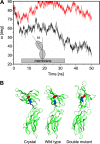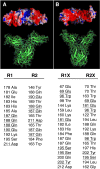Intramolecular disulfide bonds of the prolactin receptor short form are required for its inhibitory action on the function of the long form of the receptor
- PMID: 19273600
- PMCID: PMC2682051
- DOI: 10.1128/MCB.01716-08
Intramolecular disulfide bonds of the prolactin receptor short form are required for its inhibitory action on the function of the long form of the receptor
Abstract
The short form (S1b) of the prolactin receptor (PRLR) silences prolactin-induced activation of gene transcription by the PRLR long form (LF). The functional and structural contributions of two intramolecular disulfide (S-S) bonds within the extracellular subdomain 1 (D1) of S1b to its inhibitory function on the LF were investigated. Mutagenesis of the paired cysteines eliminated the inhibitory action of S1b. The expression of the mutated S1b (S1bx) on the cell surface was not affected, indicating native-like folding of the receptor. The constitutive JAK2 phosphorylation observed in S1b was not present in cells expressing S1bx, and JAK2 association was disrupted. BRET(50) (BRET(50) represents the relative affinity as acceptor/donor ratio required to reach half-maximal BRET [bioluminescence resonance energy transfer] values) showed decreased LF/S1bx heterodimeric-association and increased affinity in S1bx homodimerization, thus favoring LF homodimerization and prolactin-induced signaling. Computer modeling based on the PRLR crystal structure showed that minor changes in the tertiary structure of D1 upon S-S bond disruption propagated to the quaternary structure of the homodimer, affecting the dimerization interface. These changes explain the higher homodimerization affinity of S1bx and provide a structural basis for its lack of inhibitory function. The PRLR conformation as stabilized by S-S bonds is required for the inhibitory action of S1b on prolactin-induced LF-mediated function and JAK2 association.
Figures





Similar articles
-
Impact of subdomain D1 of the short form S1b of the human prolactin receptor on its inhibitory action on the function of the long form of the receptor induced by prolactin.Biochim Biophys Acta. 2014 Jul;1840(7):2272-80. doi: 10.1016/j.bbagen.2014.04.006. Epub 2014 Apr 13. Biochim Biophys Acta. 2014. PMID: 24735798 Free PMC article.
-
Ligand-independent homo- and heterodimerization of human prolactin receptor variants: inhibitory action of the short forms by heterodimerization.Mol Endocrinol. 2006 Aug;20(8):1912-23. doi: 10.1210/me.2005-0291. Epub 2006 Mar 23. Mol Endocrinol. 2006. PMID: 16556730
-
Prolactin receptor gene transcriptional control, regulatory modalities relevant to breast cancer resistance and invasiveness.Front Endocrinol (Lausanne). 2022 Sep 15;13:949396. doi: 10.3389/fendo.2022.949396. eCollection 2022. Front Endocrinol (Lausanne). 2022. PMID: 36187116 Free PMC article. Review.
-
Functional characterization of the intermediate isoform of the human prolactin receptor.J Biol Chem. 1999 Dec 10;274(50):35461-8. doi: 10.1074/jbc.274.50.35461. J Biol Chem. 1999. PMID: 10585417
-
New mechanisms for PRLr action in breast cancer.Trends Endocrinol Metab. 2009 Jul;20(5):223-9. doi: 10.1016/j.tem.2009.03.001. Epub 2009 Jun 15. Trends Endocrinol Metab. 2009. PMID: 19535262 Review.
Cited by
-
Mechanisms of transient signaling via short and long prolactin receptor isoforms in female and male sensory neurons.J Biol Chem. 2013 Nov 29;288(48):34943-55. doi: 10.1074/jbc.M113.486571. Epub 2013 Oct 18. J Biol Chem. 2013. PMID: 24142695 Free PMC article.
-
Complex formation and interactions between transcription factors essential for human prolactin receptor gene transcription.Mol Cell Biol. 2011 Aug;31(16):3208-22. doi: 10.1128/MCB.05337-11. Epub 2011 Jun 13. Mol Cell Biol. 2011. PMID: 21670145 Free PMC article.
-
Impact of subdomain D1 of the short form S1b of the human prolactin receptor on its inhibitory action on the function of the long form of the receptor induced by prolactin.Biochim Biophys Acta. 2014 Jul;1840(7):2272-80. doi: 10.1016/j.bbagen.2014.04.006. Epub 2014 Apr 13. Biochim Biophys Acta. 2014. PMID: 24735798 Free PMC article.
-
Prolactin-induced protein (PIP)-characterization and role in breast cancer progression.Am J Cancer Res. 2018 Nov 1;8(11):2150-2164. eCollection 2018. Am J Cancer Res. 2018. PMID: 30555735 Free PMC article. Review.
-
The prolactin receptor long isoform regulates nociceptor sensitization and opioid-induced hyperalgesia selectively in females.Sci Transl Med. 2020 Feb 5;12(529):eaay7550. doi: 10.1126/scitranslmed.aay7550. Sci Transl Med. 2020. PMID: 32024801 Free PMC article.
References
-
- Acosta, J. J., R. M. Munoz, L. Gonzalez, A. Subtil-Rodriguez, M. A. Dominguez-Caceres, J. M. Garcia-Martinez, A. Calcabrini, I. Lazaro-Trueba, and J. Martin-Perez. 2003. Src mediates prolactin-dependent proliferation of T47D and MCF7 cells via the activation of focal adhesion kinase/Erk1/2 and phosphatidylinositol 3-kinase pathways. Mol. Endocrinol. 172268-2282. - PubMed
-
- Ali, S., and S. Ali. 2000. Recruitment of the protein-tyrosine phosphatase SHP-2 to the C-terminal tyrosine of the prolactin receptor and to the adaptor protein Gab2. J. Biol. Chem. 27539073-39080. - PubMed
-
- Aman, M. J., T. S. Migone, A. Sasaki, D. P. Ascherman, M. Zhu, E. Soldaini, K. Imada, A. Miyajima, A. Yoshimura, and W. J. Leonard. 1999. CIS associates with the interleukin-2 receptor beta chain and inhibits interleukin-2-dependent signaling. J. Biol. Chem. 27430266-30272. - PubMed
-
- Bazan, J. F. 1989. A novel family of growth factor receptors: a common binding domain in the growth hormone, prolactin, erythropoietin and IL-6 receptors, and the p75 IL-2 receptor beta-chain. Biochem. Biophys. Res. Commun. 164788-795. - PubMed
-
- Bole-Feysot, C., V. Goffin, M. Edery, N. Binart, and P. A. Kelly. 1998. Prolactin (PRL) and its receptor: actions, signal transduction pathways and phenotypes observed in PRL receptor knockout mice. Endocr. Rev. 19225-268. - PubMed
Publication types
MeSH terms
Substances
Grants and funding
LinkOut - more resources
Full Text Sources
Miscellaneous
